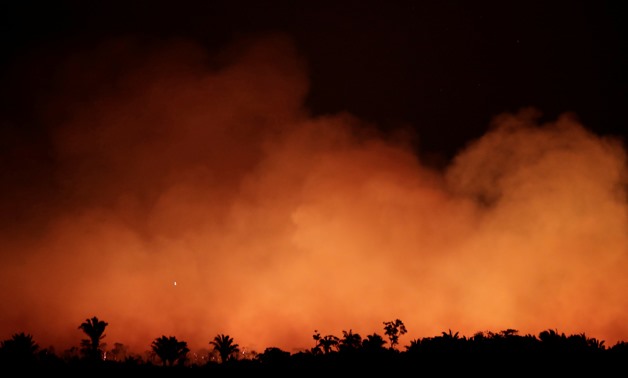
Smoke billows during a fire in an area of the Amazon rainforest near Humaita, Amazonas State, Brazil, Brazil August 17, 2019. Picture Taken August 17, 2019. REUTERS/Ueslei Marcelino
CAIRO – 22 August 2019: For more than two weeks, the world’s largest rainforests of Amazon have been burning.
US Space agency NASA said on Twitter on Thursday that the Amazon fires this season are record-breaking, publishing an image for the first taken by Suomi NPP satellite two days ago.
Brazilian President said in a press conference on Wednesday that NGOs are blamed on burning Amazon rainforests to “embarrass” his government, The Guardian reported.

A tract of Amazon jungle is seen burning as it is being cleared by loggers and farmers in Iranduba, Amazonas state, Brazil August 20, 2019. REUTERS/Bruno Kelly
Amazon is the largest tropical rainforests all over the world and home of 33 million people, including 420 indigenous communities, according to the United Nations Food and Agricultural Organization (FAO).

Smoke billows during a fire in an area of the Amazon rainforest near Porto Velho, Rondonia State, Brazil, Brazil August 21, 2019. REUTERS/Ueslei Marcelino
According to the National Geographic, the forests are inhabited by 40,000 plant species, 1,300 bird species, 430 mammals, 2.5 million insects, and 3,000 species of fish.
Social media users on Twitter created a hashtag #PrayForTheAmazon, reacting to the devastating rainforest fires.
The ongoing devastating fires participate in increasing the rate of carbon dioxide into air although some countries have moved to plant billions of trees to to help curb carbon dioxide emissions globally and limit the impacts of climate change.
Late July 2019, Ethiopia planted more than 350 million trees in only 12 hours, while India planted only about 60 million trees in 2016.

Smoke billows during a fire in an area of the Amazon rainforest near Humaita, Amazonas State, Brazil, Brazil August 14, 2019. Picture Taken August 14, 2019. REUTERS/Ueslei Marcelino
A study was published by Science in July and revealed that the universe has to cultivate 1 billion hectares of trees to limit the impacts of climate change.
Scientists estimated that growing 0.9 billion trees can absorb 25 percent of carbon dioxide, saying “We estimate that if we cannot deviate from the current trajectory, the global potential canopy cover may shrink by ~223 million hectares by 2050, with the vast majority of losses occurring in the tropics. Our results highlight the opportunity of climate change mitigation through global tree restoration but also the urgent need for action.”




Comments
Leave a Comment